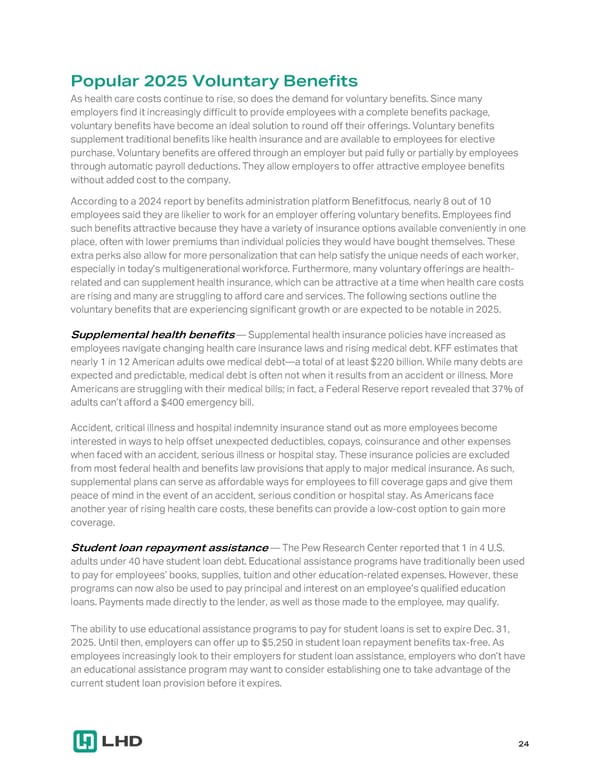Popular 2025 Voluntary Benefits As health care costs continue to rise, so does the demand for voluntary benefits. Since many employers find it increasingly difficult to provide employees with a complete benefits package, voluntary benefits have become an ideal solution to round off their offerings. Voluntary benefits supplement traditional benefits like health insurance and are available to employees for elective purchase. Voluntary benefits are offered through an employer but paid fully or partially by employees through automatic payroll deductions. They allow employers to offer attractive employee benefits without added cost to the company. According to a 2024 report by benefits administration platform Benefitfocus, nearly 8 out of 10 employees said they are likelier to work for an employer offering voluntary benefits. Employees find such benefits attractive because they have a variety of insurance options available conveniently in one place, often with lower premiums than individual policies they would have bought themselves. These extra perks also allow for more personalization that can help satisfy the unique needs of each worker, especially in today’s multigenerational workforce. Furthermore, many voluntary offerings are health- related and can supplement health insurance, which can be attractive at a time when health care costs are rising and many are struggling to afford care and services. The following sections outline the voluntary benefits that are experiencing significant growth or are expected to be notable in 2025. Supplemental health benefits — Supplemental health insurance policies have increased as employees navigate changing health care insurance laws and rising medical debt. KFF estimates that nearly 1 in 12 American adults owe medical debt—a total of at least $220 billion. While many debts are expected and predictable, medical debt is often not when it results from an accident or illness. More Americans are struggling with their medical bills; in fact, a Federal Reserve report revealed that 37% of adults can’t afford a $400 emergency bill. Accident, critical illness and hospital indemnity insurance stand out as more employees become interested in ways to help offset unexpected deductibles, copays, coinsurance and other expenses when faced with an accident, serious illness or hospital stay. These insurance policies are excluded from most federal health and benefits law provisions that apply to major medical insurance. As such, supplemental plans can serve as affordable ways for employees to fill coverage gaps and give them peace of mind in the event of an accident, serious condition or hospital stay. As Americans face another year of rising health care costs, these benefits can provide a low-cost option to gain more coverage. Student loan repayment assistance — The Pew Research Center reported that 1 in 4 U.S. adults under 40 have student loan debt. Educational assistance programs have traditionally been used to pay for employees’ books, supplies, tuition and other education-related expenses. However, these programs can now also be used to pay principal and interest on an employee’s qualified education loans. Payments made directly to the lender, as well as those made to the employee, may qualify. The ability to use educational assistance programs to pay for student loans is set to expire Dec. 31, 2025. Until then, employers can offer up to $5,250 in student loan repayment benefits tax-free. As employees increasingly look to their employers for student loan assistance, employers who don’t have an educational assistance program may want to consider establishing one to take advantage of the current student loan provision before it expires. 24
 2025 Employee Benefits Market Outlook Page 23 Page 25
2025 Employee Benefits Market Outlook Page 23 Page 25